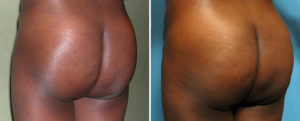Buttock augmentation is most consistently done with a gluteal implant. Despite its predictable improvement in the size and shape of the buttocks, buttock implants are not without complications. Intramuscular implant placement makes recovery more uncomfortable and having to sit on the implant predisposes it to positional shifting and the formation of fluid collections and possible infection.

The burning question through the past several decades is…how to make fat grafting work better. The injection technique is, of course, important but is only half of the answer. How the fat is prepared after harvest in the oeprating room is the other half. Everyone agrees that concentration is very important after harvest. This is the mechanical process of removing the liquids from the more solid fat components. Whether this is done by a centrifuge or passing the fat aspirate through a strainer or sieve are two methods of which one has not been proven to be better than the other. Additives to the fat are theoretically appealing but there is no universal magical additive. Currently, I add platelet-rich plasma (PRP) to the concentrated fat prior to injection. Whether this aids fat survival is not proven but since it is a product of the patient, there is no risk in so doing. PRP is a concentrate of a patient’s own blood done at the time of surgery. While there is no standardized amount of PRP to add to fat, I typically use 3cc of PRP per buttock graft site.
If a patient opts for buttock augmentation with fat injections, they must accept that the amount of fat that will survive is unpredictable. It may require more than one injection session to obtain the best result. Most fat grafting methods may not achieve the degree of volume enhancement that a gluteal implant will.
Dr. Barry Eppley
Indianapolis, Indiana


